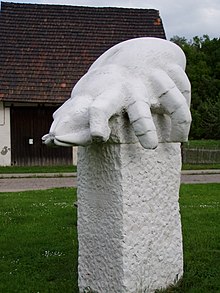Würchwitz mite cheese
The milbenkäse , mundartlich also Mellnkase called, is a cheese specialty from the Saxony-Anhalt Würchwitz that a district of the city today Zeitz is. Cheese mites of the species Tyrophagus casei , whose enzymes are responsible for ripening, are used in the production of the cheese . In almost all other types of cheese, rennet enzymes or lactic acid bacteria are responsible for the ripening process.
Manufacturing
For the production, a thoroughly dehydrated and a few days dried cream cheese in the lean stage with a fat content in the dry matter of about 1% is first seasoned, especially with salt and caraway seeds , and then z. B. formed into rods or palm-sized balls in which there is an elderflower panicle , the stem protrudes from the ball. This shape, known as elderberry pear, enables the mites to penetrate the cheese in order to also contribute to the ripening process from the inside. The shaped cheeses are then stored for one to twelve months in a box containing several million cheese mites ( Tyrophagus casei ). A wheel of cheese is populated by around 500,000 of these 0.3 mm mites. Rye flour is also used to feed the mites . This also prevents the mites from eating too much of the cheese themselves. The mites' saliva probably causes fermentation of the raw cheese. In the course of the ripening process, which takes place from the outside to the inside, the exterior of the cheese turns yellow after about four weeks, until it turns reddish brown after three months and finally a blackish color after a year. When the cheese is consumed, the mites are still alive and are eaten with them.
Its taste is reminiscent of a Harz cheese, which is light to extremely strong, depending on the degree of aging, with a sparkling, slightly bitter aftertaste. The smell is u. a. salmiac-like .
The consumption of the cheese is harmless to health. The production is approved by the Food Office and is checked regularly, and in-house microbiological controls are also carried out on a regular basis .
history
Cheese mites have been grown in the area around Zeitz and Altenburg since the Middle Ages . Since mite infestation was a well-known problem in cheese storage in earlier times, mite cheese production was made a virtue of necessity by including the mites , which are actually pests , in the production process as farm animals . Around 1970 the tradition threatened to be lost, as only one elderly woman, Liesbeth Brauer, made mite cheese in Würchwitz. The resident biology and chemistry teacher Helmut Pöschel then began to breed mites himself and was committed to reviving the tradition by doing public relations work and setting up various events.
A few years ago, on the occasion of the traditional clover festival, a memorial was erected on the cheese mite on the village square in Würchwitz. Recently, through the initiative of Helmut Pöschel and Christian Schmelzer, the mite cheese was introduced into the Arche of Taste , an international project by Slow Food e. V. recorded.
See also
literature
- Jahns, Horst: The mite cheese and Europe. In: ders .: Ostbrötchen and Troddeldatschen. Mitteldeutscher Verlag, Halle (Saale) 2002, ISBN 3-89812-138-0 , pp. 45–54.
- Thurm, Volker: The liveliest cheese in the world - Würchwitz mite cheese: a German specialty (2nd edited and extended edition). Kayna et al. a .: Kleefestverein Würchwitz 1851 e. V., 2002.
- Herrmann, Silvio: The regional specialty “Altenburger Mitbenkäse”, an analysis of the product, the production and the market , Diplomica Verlag, Hamburg 2005. Excerpts here online (accessed on February 13, 2015).
Web links
- www.milbenkaese.de
- Homepage of the mite cheese museum Würchwitz
- Mite cheese at Slow Food Germany e. V.
- The big crawl on cheese (Innovation - on zeiss.de) ( Memento from March 5, 2012 in the Internet Archive ) (PDF, 610 kB)
Individual evidence
- ↑ dpa: Saxon mite cheese as a delicious delicacy. Die Welt, February 19, 2014, accessed on February 19, 2014 .
- ↑ http://www.slowfood.de/biodiversitaet/die_arche_passagiere/wuerchwitzer_milbenkaese/ Würchwitzer Mitbenkäse from Slow Food Germany, accessed May 28, 2015


